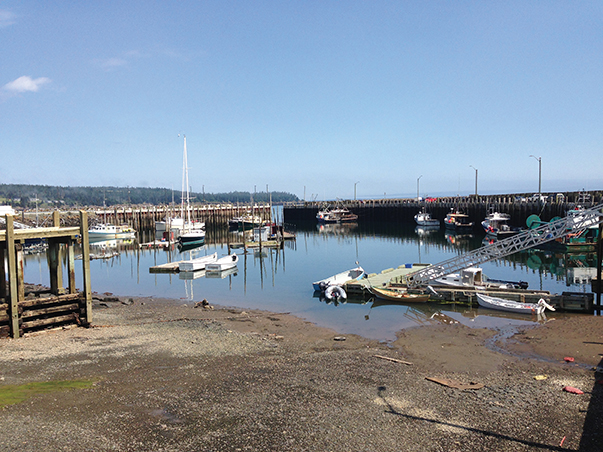The people and picturesque villages of Grand Manan make the challenge of fog and new harbor entrances worthwhile (published August 2015)
WHITE HEAD HARBOR
“See the gulls in the water where the chart shows the harbor entrance?”
“Yeah,” I said.
“Isn’t that gull walking?” Kareen asked me. We had the Canadian paper chart out and were scratching our heads, comparing it to the image on our GPS plotter, along with what we were seeing by eye. Curious? The entrance just did not seem to be in the right place. Where the chart indicated an entrance, all we saw were mud and ledges.
Hmmm?… as we drifted slowly in a wide circle outside the harbor considering the situation, the cockpit VHF gave a burst of static and we heard a garbled voice.
“Calling the yacht in trouble outside White Head Harbor, this is the Lady White Head.” Kareen and I glanced at each other with the same thought—was that person calling us?
The radio interrupted again, “Calling the American yacht in trouble outside White Head Harbor, this is the Lady White Head.”
I keyed the cockpit microphone, “Lady White Head, this is sailing vessel Patience, over.”
“Yah, Patience, is that you outside White Head Harbor? I can see you by eye and on my radar, and I don’t like how close you are to what we call the Half Tide Rock. I am thinking you might be in trouble.”
“Lady White Head if we are in trouble, the first time we knew it was when you told us! We see Half Tide Rock, and I’ll just give us a chuff of power away from it. We were just scratching our heads here on the proper harbor entrance channel to White Head Island.”
“Patience, I am the ferry that goes between Grand Harbour and White Head Island, and I am behind you in the haze. The chart is drawn wrong. The correct entrance channel is to the north and east of the line of stakes you see there. Just stay away from Half Tide Rock. Hug the stakes to starboard, only three to four meters to starboard, and follow them around to the inner harbor.”
We pulled out the binoculars and we could see the small landing craft style ferry chugging toward us between the winding channel markers from Grand Harbour on Grand Manan.
“Lady White Head, Patience. Thanks for that, skipper. But say again, you mean leave the stakes to PORT on that channel entrance, not starboard, correct?”
“Negative Cap, Negative. The chart is incorrect. Do not follow the chart. You leave the stakes to STARBOARD by just a bit, and there’s a deep channel, plenty deep enough for this ferry, say 10 feet at low water all the way into the harbor.”
“Lady White Head, we thank you. It’s our first time here and we were a bit bewildered looking at the chart. See you in the harbor.”
As we entered the pocket sized harbor, a small car drove down onto the pier with a middle aged fellow smiling and waving at us. He hopped out of the car and came to the side of the pier gesturing to come alongside a fishing boat called Knight Moves.
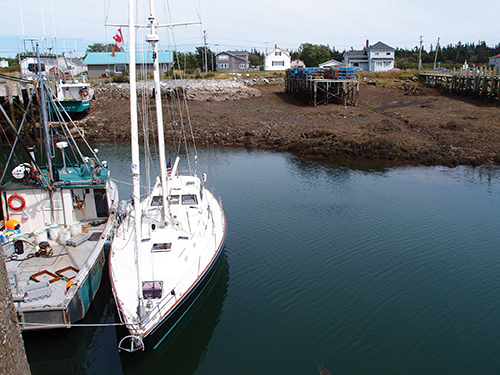
He climbed down on Knight Moves and said, “Welcome to White Head Island, my name is Barry, let me help you tie up.”
I said, “Thanks Barry, appreciate it! But look, the harbor is kinda tight and we don’t want to inconvenience any of the fishing boats in here. We are happy to tie up alongside the concrete pier in the corner out of the way.”
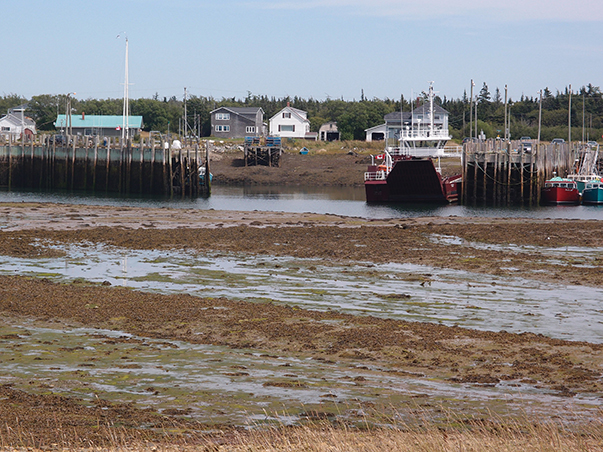
Barry responded, “The water’s awfully thin in there at low tide, and you’d have to tend your lines what with the six meter tide this time of the month. Just tie up alongside Brian’s boat here. He’s a lobsterman so he isn’t likely to be going anywhere ‘til November.”
When we asked how many other cruising boats flying the Stars ’n Stripes they see, he answered, “you’re the first one this season.” Barry talked with us about the weather, his fishing plans, and the fact that he was the only local sailor, with a new to him 30-foot Hallberg-Rassy sloop.
Barry stood and talked to us long enough that I thought it was only sporting to ask: “Would you like to come aboard for a cuppa tea or a cold drink?” His answer was “Oh yes, I would, but would you mind if I go home and fetch my wife fust?”
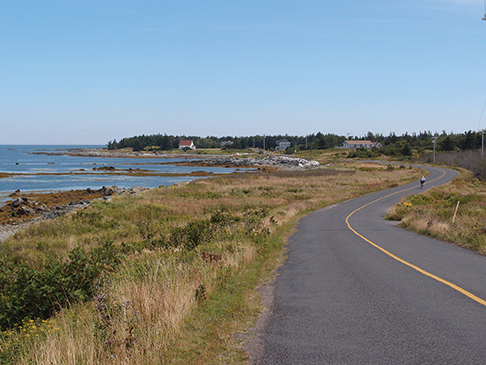
GRAND MANAN ISLAND
That story happened a few years back in 2011. In 2013 our August cruise in Maine concluded with a perfect day on the Great Beach at Roque Island, we checked the weather looking for a front to generate a northerly to send us downwind back west and south. What it looked like instead was four to five days of unbroken beautiful blue sky weather. High pressure, not much breeze and what there was, south to southwest. We figured, hey, why fight Mother Nature? Let’s head out to Grand Manan for the weekend.
When you’re on the hook at Roque and lusting for a bit more adventure, it’s only 40 miles to Seal Cove on the south end of Grand Manan Island.
Most cruising guides and cruisers recommend heading to North Head, on the northeast corner of the island. We like it there too, but for us the charm of the red painted village and the smell of the smoked herring in Seal Cove always called out to us. It’s 20 miles closer than North Head, and an added bonus is it is only about four miles from Seal Cove to White Head Island on the southeastern corner of Grand Manan in New Brunswick, smack in the middle of the Bay of Fundy, This is one of our favorite cruising grounds on earth, yet the cruising guides all say to stay away from the southeast corner.
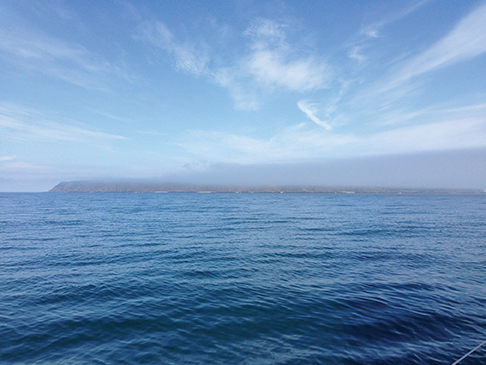
As we motored toward the entrance to Seal Cove in August, the fog was lifting in the distance, but was still thick at the entrance. I called out from the helm to Kareen on the bow, “The sea walls look different to me… They seem to be staggered somehow.” Not enough to keep us from entering, just not quite what I remembered. Maybe it was the fog.
From the bow Kareen called back, “Nope, entrance looks fine to me; nobody coming at us” (meaning with a narrow enough entrance to only accept one boat entering or exiting at a time no one was coming at us!). We motored slowly inside the harbor, still in thick fog, and slithered up alongside an older, mostly broken down lobster car. Our experience had been that the lobster cars were unused in the summertime as the lobster seasons are in the spring and fall. As usual, we immediately went ashore and looked for someone to ask if it would be okay to tie alongside overnight.
“Like your boat,” I commented to a fisherman hosing the cockpit on a large Novi style boat. “We were wondering if we’ll be in anyone’s way if we tie up to that lobster car over there for the night?”
He asked, “That your boat over theya?”
“Ahhh… Yep,” I replied
“ Pretty boat,” he said. “Saw you come in. Looked like you been here before.”
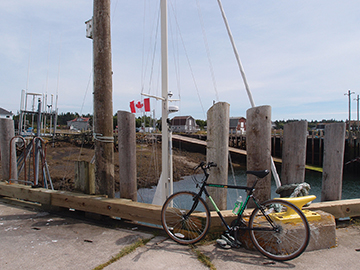
“We have. You live in a beautiful place and we love your island. So, we are wondering if we’ll be out of the way if we stay on that lobster car overnight. We were planning to do some bicycling tomorrow but we don’t want to impose on anyone’s space.”
“Well, that lobster car ought to be fine; he’s closed up for the season.” He said, “ But by gorry, if you need anything, don’t bicycle, hell, you can just take my truck up there on the wharf any time. It’s the green GMC and the keys are in it.”
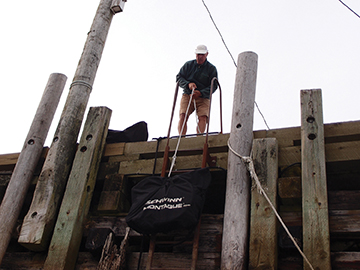
We learned not only that we could bike or truck, but that since the last time we’d been in the harbor, it had received a $20 million investment from the provincial government to double the size of the harbor. The difference we noticed in the fog-shrouded entrance was actually the entrance to the new second harbor, just northeast of the original one. Not yet on our chart, the harbor should be a terrific resource for cruising yachts as it has over 500 feet of float space (meaning you don’t have to tend lines with the 15 to 20 foot tide range) and is dredged to a depth of 12 feet or so from seawall to seawall. What a terrific benefit this will be for this economically challenged area.
We also learned, the old-fashioned way, that some lobster cars were very active in the middle of summer. By 10 p.m. that evening, we heard the roar of a diesel engine and the swish of its prop wash on the lobster car next to ours, now lit up by the bright white sodium deck lights on the 50-foot vessel unloading alongside it. The country music was just a teensy bit louder than the unmuffled dry stack engine. We watched from our pilothouse as the crew exchanged insults with the operators of the car as they weighed plastic lobster boxes. We wondered, and got ready for bed. Then… Brrrrrrooooooom, swish!
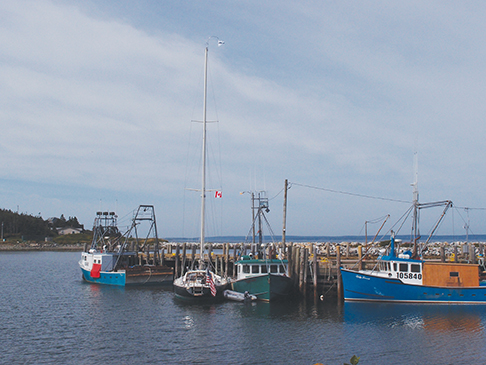
Another big offshore lobster boat came alongside the car, and began unloading—five crew on that boat. Where in the world were they lobstering this time of year? A little poaching is plausible, but these were high-liners on large, fully equipped, well-maintained vessels. And if I wasn’t mistaken, there was another one at the harbor entrance getting ready to come in for un-loading. I needed to discover the answer.
“Nice night” I shouted as I sprung up onto the lobster car from our inflatable. Cigarette dangling, the kid nodded, not stopping his work from hooking and weighing the boxes on a rusty old scale.
“How ‘ya doin?” I asked. “Looks like the fishing is pretty good.”
“Oh yeah, today it was. Awfully sorry about the noise. They have a new muffler coming in from Hamilton’s but it didn’t show up on today’s ferry.”
“Oh the noise doesn’t bother us,” I said. “We’re just wondering how’s the catch.”
“Good, think we got ‘bout 1,800 keepers t’day.” “Whew,” I whistled, “1,800! That’s good fishing. Sorry for the dumb question, but I thought the lobster season was closed right now.”
“Weeeeell, that’s technically true, it is.” The kid said. “But we’re fishin’ on the ‘gray line’—the line between Canada and the States where it’s open to a little interpretation where the actual border is. So since the border isn’t clear, neither is the enforcement of the lobster season .. ha ha ha!”
“Now it’s kinda lumpy out there,” he continued, “and the fishing isn’t always as good as t’day, but we figure it’s a helluva lot better than just feedin’ the salmon pens or waiting for the real season to open in November.”
Back aboard Patience, scratching my head, I wondered aloud, “Is the demand for lobster so great that the price will hold up no matter the supply?” Personally I wouldn’t think so, but Kareen says I am delusional. The demand for lobster from places like Red Lobster or Chili’s is insatiable. If they had more availability, they would likely “value price” or “super-size,” and Americans would come in and eat all they could get (and then some).
The next morning, with coffees in hand, we were talking with a 70-something lobsterman on the wharf. We speculated on the state of the world. Kareen and I got instructed in a little Grand Manan Philosophy 101. He spoke of the Seal Cove and White Head lifestyle and the historical necessity for resourcefulness, which is now changing with increased regulation taking the place of personal responsibility.
He shook his head. “Life is beginning to be governed by well-meaning bureaucrats in Ottawa who know what is in our best interest better than we do, but are clueless about resourcefulness or resilience. They seek short term, politically favorable budget solutions over long term quality lifestyles. That’s progress?” he asked.
“Hmmm…I guess it’s the same all over,” we said.
So there you have it. There’s an interesting cultural entropy going on in these island communities. You have a lot of learned resourcefulness. You have skilled, gritty fishermen, comfortable and still quite happy with their risky but independent way of life; often curious to learn about the rest of the world, but secure in the knowledge that they have a high quality lifestyle. And looking out for strangers who come their way, like cruising sailors trying to find a channel and a spot to tie up for the night.
Then, external change. Since so much of the offshore fishing has been halted or significantly reduced in the Maritimes, much of the activity has centered on the relatively new cultivated salmon industry—raising salmon in pens requires feeding from large sacks of feed transported to the pens in former lobster boats. The well-meaning bureaucrat’s concept was that the change would spur Canadian fishermen to continue to be independent solo owner-operator entrepreneurs. What has actually happened in this part of Canada is that all of the rights to the salmon pens have been acquired by large corporate entities like Cook Brothers in Black Harbor, NB. So most of the feed boats operators now are either employees working by the hour, or contract day workers paid by the day. The majority of the locals have devolved from independent entrepreneur business owners to wage earners selling time by the hour.
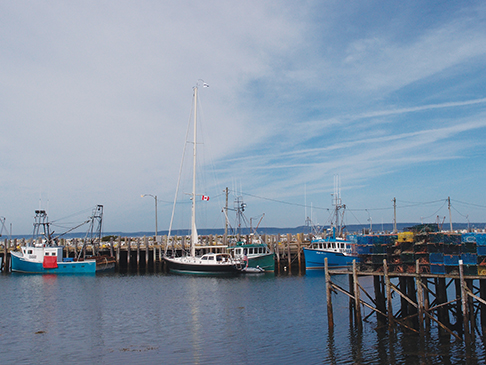
RETURN JOURNEY
On this trip, we had the added good fortune to be cleared into the United States for the first time since 9/11 by U.S. Customs & Border Patrol on our cellphone. It’s always been easy for us to clear into Canada by phone by calling a number in Ottawa that took note of our vessel name and Coast Guard documentation number before saying, “welcome back to Canada, Pete,” and issuing a CANPASS number. We always thought the Canadians had a good system. And after 9/11 we have put up with the increased scrutiny, understanding what it’s intended for. But it sure is great that if you are properly registered, licensed, and have your passport numbers at the ready … that you will be able clear in and out of the U.S. and Canada regularly … like the friendly cruising sailors we all are!
Sure, east of Schoodic there will be fog from time to time, and you will have to consult the current tables (not tide height but current times). We use the “Grand Manan Channel Entrance” table if we’re going there. It may mean a really early morning but we wouldn’t dream of trying to go up or down the Bay of Fundy fighting an adverse current if we had any choice. The slack before the ebb was at about 0500 on that Monday, so we got an early start and carried the fair current almost all the way back to Poets Harbor on Pleasant Bay, where we stopped to see CCA friends Diane and Jack Myles (FLA). Sweeping by Machias Seal Island looking for puffins, or cutting close between Seal Island and North Rock, is an adventure, but an easily attainable one in the mostly benign August cruising weather in the Bay of Fundy. Cruising Fundy in the summer is great—no lobster pot buoys in the summer (except in the gray zone), Woohoo!!! You can experience paradise and tap its positive energy only 40 miles from Roque Island.
Pete and Kareen Worrell have cruised together for over 30 years from their home in Portsmouth, New Hampshire, on a succession of vessels named Patience. Their current affair is with a Hood Pilothouse 51-foot sloop. In the middle of their professional careers, both have fit in cruising adventures to Labrador and Newfoundland, the West Indies, plus coastal Ireland and England. In New Zealand, they have voyaged from the Bay of Islands to the subantarctic Auckland Islands.
















